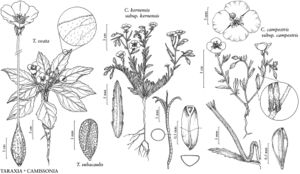Taraxia ovata
Bull. Torrey Bot. Club 23: 185. 1896.
Herbs densely, sometimes sparsely, short-hirsute, especially on leaf blade margins and ± veins; taproot thick, often branched in age, producing new rosettes. Leaves 3–15 × 1.6–5 cm; petiole narrowly winged, 0.8–15 cm, base slightly dilated; blade ovate to very narrowly elliptic, base attenuate, margins usually subentire to shallowly sinuate or crisped, rarely deeply sinuate, apex acute to acuminate. Flowers opening near sunrise; floral tube 2–3 mm, with short, matted hairs inside near base; sepals 11–19 mm; petals usually yellow, rarely white, 8–23 mm; episepalous staminal filaments 3.5–8 mm, epipetalous ones 2–6 mm, anthers 3–5 mm; sterile prolongation of ovary 25–180 mm, style 4.5–11 mm, shortly pubescent near base, stigma exserted slightly beyond anthers at anthesis. Capsules subterete, cylindric-lanceoloid, 11–30 × 3–5 mm, walls thin, much distended by seeds; rarely with pedicel to 0.4 mm. Seeds uniformly brown, elongate-ovoid, 1.8–2.2 × 1.2–1.4 mm, densely and coarsely papillose. 2n = 14.
Phenology: Flowering Feb–May.
Habitat: Grassy fields, clay soil, usually near coast.
Elevation: 0–500 m.
Discussion
Taraxia ovata occurs in counties near the coast and is found in Humboldt, Lake, and Mendocino counties south to the vicinity of Monterey Bay, Monterey County, and again south of the Santa Lucia Mountains in northern San Luis Obispo County, California, and Douglas and Josephine counties in Oregon. It has no close relatives in the genus (P. H. Raven 1969), an assertion supported by its early branching in molecular analyses (R. A. Levin et al. 2004; W. L. Wagner et al. 2007). The species is self-incompatible and pollinated by the oligolectic bee Andrena (Diandrena) chalybea (Cresson) (Raven).
Oenothera primuloidea H. Léveillé is an illegitimate, superfluous name that pertains here.
Selected References
None.
